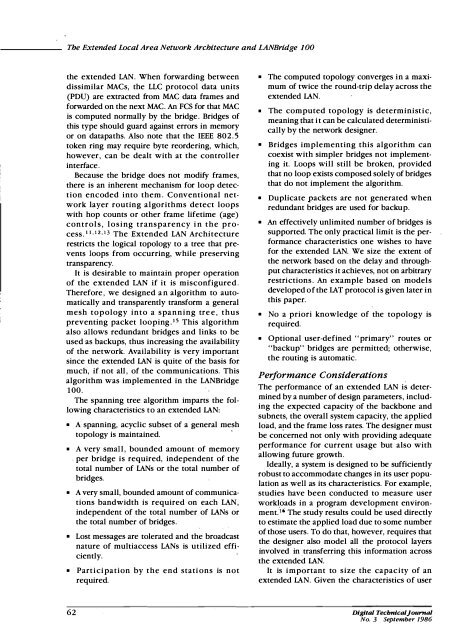DTJ Number 3 September 1987 - Digital Technical Journals
DTJ Number 3 September 1987 - Digital Technical Journals
DTJ Number 3 September 1987 - Digital Technical Journals
Create successful ePaper yourself
Turn your PDF publications into a flip-book with our unique Google optimized e-Paper software.
The Extended Local Area Network Architecture and LANBridge 100the extended LAN. When forwarding betweendissimilar MACs, the LLC protocol data units(PDU) are extracted from MAC data frames andforwarded on the next MAC. An FCS for that MACis computed normally by the bridge. Bridges ofthis type should guard against errors in memoryor on datapaths. Also note that the IEEE 802.5token ring may require byte reordering, which,however, can be dealt with at the controllerinterface.Because the bridge does not modify frames,there is an inherent mechanism for loop detectionencoded into them. Conventional networklayer routing algorithms detect loopswith hop counts or other frame lifetime (age)controls, losing transparency in the process.ll· 12• 1 3 The Extended LAN Architecturerestricts the logical topology to a tree that preventsloops from occurring, while preservingtransparency.It is desirable to maintain proper operationof the extended LAN if it is misconfigured.Therefore, we designed an algorithm to automaticallyand transparently transform a generalmesh topology into a spanning tree, thuspreventing packet looping.15 This algorithmalso allows redundant bridges and links to beused as backups, thus increasing the availabilityof the network. Availability is very importantsince the extended LAN is quite of the basis formuch, if not all, of the communications. Thisalgorithm was implemented in the LANBridge100.The spanning tree algorithm imparts the followingcharacteristics to an extended LAN:• A spanning, acyclic subset of a general meshtopology is maintained.• A very small, bounded amount of memory. per bridge is required, independent of thetotal number of LANs or the total number ofbridges.• A very small, bounded amount of communicationsbandwidth is required on each LAN ,independent of the total number of LANs orthe total number of bridges.• Lost messages are tolerated and the broadcastnature of multiaccess LANs is utilized efficiently.• Participation by the end stations is notrequired.• The computed topology converges in a maximumof twice the round-trip delay across theextended LAN.• The computed topology is deterministic,meaning that it can be calculated deterministicallyby the network designer.• Bridges implementing this algorithm cancoexist with simpler bridges not implementingit. Loops will still be broken, providedthat no loop exists composed solely of bridgesthat do not implement the algorithm.• Duplicate packets are not generated whenredundant bridges are used for backup.• An effectively unlimited number of bridges issupported. The only practical limit is the performancecharacteristics one wishes to havefor the extended LAN. We size the extent ofthe network based on the delay and throughputcharacteristics it achieves, not on arbitraryrestrictions. An example based on modelsdeveloped of the IAT protocol is given later inthis paper.• No a priori knowledge of the topology isrequired.• Optional user-defined "primary" routes or"backup" bridges are permitted; otherwise,the routing is automatic.Performance ConsiderationsThe performance of an extended LAN is determinedby a number of design parameters, includingthe expected capacity of the backbone andsubnets, the overall system capacity, the appliedload, apd the frame loss rates. The designer mustbe concerned not only with providing adequateperformance for current usage but also withallowing future growth .Ideally, a system is designed to be sufficientlyrobust to accommodate changes in its user populationas well as its characteristics. For example,studies have been conducted to measure userworkloads in a program development environment.1 6 The study results could be used directlyto estimate the applied load due to some numberof those users. To do that, however, requires thatthe designer also model all the protocol layersinvolved in transferring this information acrossthe extended LAN.It is important to size the capacity of anextended LAN. Given the characteristics of user62<strong>Digital</strong> Tecbnical]ournalNo. 3 <strong>September</strong> 1986









